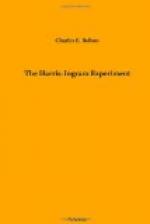Mr. Bessemer explained many things, and offered many valuable suggestions. A remark of Mr. Bessemer to George Ingram led the latter to tell Bessemer a story which he heard in the smoking-room of the S.S. “Campania.”
“Two Irishmen once tried to sleep, but could not for Jersey mosquitoes had entered their bedroom. Earnest effort drove the mosquitoes out, and the light was again extinguished. Soon Mike saw a luminous insect, a big fire-fly approaching. Quickly he roused his companion saying, ’Pat, wake up! Quick! Let’s be going! It’s no use trying to get more sleep here, there comes another Jersey mosquito hunting us with a lantern.’”
Mr. Bessemer was amused, and he ventured the assertion that when electricity could be as cheaply produced directly from coal as the light by the fire-fly, and successfully delivered in our great cities, the smoke nuisance would be effectually abated, all freight charges on coal would be saved, and coal operators could utilize all their slack at the mines.
“Do you think this possible?” inquired Colonel Harris.
“Oh, yes, quite possible,” answered Bessemer, “our necessities beget our inventions and discoveries. Thorough investigation in the near future on this and kindred lines must be fruitful of astonishing results in the interests of a higher civilization.” The colonel and George took their leave. Truly the fire-fly, like the whirling hot nail, is suggestive of great possibilities, thought George.
That evening it was planned to visit on the morrow the extensive telegraphic works of Siemens Brothers & Co., Limited. George retired to sleep, but his mind was never more active. On warm summer evenings he had often held in his hand glow-worms and studied them as they emitted bright phosphorescent light. He had learned that this faculty was confined to the female which has no wings, and that the light is supposed to serve as a beacon to attract and guide the male. The light proceeds from the abdomen, and its intensity seems to vary at will. He had also read of a winged, luminous insect of South America, which emits very brilliant light from various parts of its body.
When George reflected that under even the most favorable conditions there was realized in mechanical work of the energy stored in coal only 10%, he was convinced that the extravagant waste of 90% of energy was in itself sufficient argument against the present method as being the best possible. Ever since his graduation, he had believed that the greatest of all technical problems was the production of cheaper power. That it was the great desideratum in cities in the production of food, and in food transportation from farms to trunk lines, on railways and on the ocean.
While in America he had discussed the matter of cheaper power with Edison, Thompson, Tesla, and others.
George and his father, James Ingram, experimenting with chemical energy, had already discovered a galvanic element which enabled them to furnish electrical energy direct from coal and the oxygen of the air, but this important discovery was kept a secret. The chief object of George Ingram’s visit abroad was to follow the footsteps of other great scientists and manufacturers to the edge or frontier of their discoveries and practical workings.




